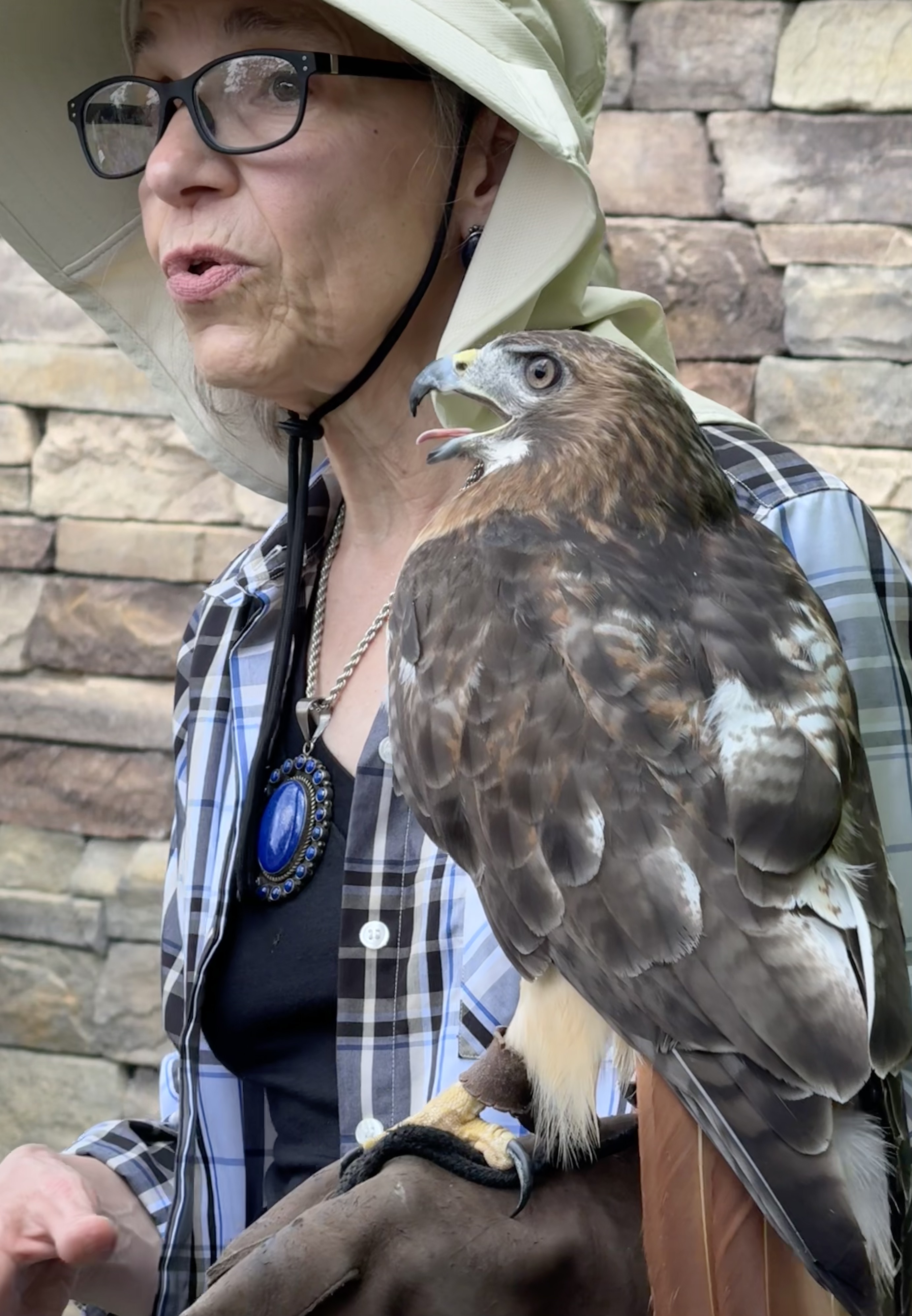Raptor rehabilitator and educator, Liz Dennison, with her Secret Garden Birds and Bees non-profit volunteers, recently presented some how-to tips to attract raptors to area backyards as she introduced several of her birds at Burke Centre Library. They come with the side benefit of controlling animal and insect pests.
“It is definitely desirable to attract raptors to your backyard and community,” Dennison says. As top
 Raptor rehabber, Liz Dennison with her Red-tailed Hawk, Big Red, who lost his vision in one eye after a car collision making it impossible for him to hunt effectively in the wild
Raptor rehabber, Liz Dennison with her Red-tailed Hawk, Big Red, who lost his vision in one eye after a car collision making it impossible for him to hunt effectively in the wild
Eagles and Osprey catch and eat fish. Overall, raptors have a varied diet and help keep populations of animals and insects in control.
Dennison shares that attracting raptors to your backyard “involves creating as natural an environment as possible. Raptors need food, shelter, and a safe place to raise their young.
Native plants are a good place to start because they attract the insects that many birds, even raptors, feed to their young. It helps to have a wild area where you let the grass or weeds grow tall; or even have a little brush pile, as a home for the small rodents, and a shelter for songbirds. And all wildlife appreciates a water source in all seasons. A few big trees suitable for a hawk's stick nest, and some old trees - even dead ones - with cavities for nesting. [Putting up] nest boxes are also a possibility. Keeping the night dark and quiet helps too. I know this is a lot and not always possible on one property or because of HOA rules. But every little bit makes a difference, even a small balcony garden or window box [for native plants].”
Raptors could use our help. Many succumb to rodenticide poisoning from eating rodents who have ingested the poison, or from lead poisoning from eating animals, such as deer carcasses shot with lead ammunition, or from ingesting lead fishing weights when feeding on fish. So, Denison says, a raptor-friendly environment should absolutely not include rodenticides, nor insecticides. Sadly raptor death or injury from collision with vehicles is also a global problem. The birds are drawn to roadway areas in search of prey. Most of Secret Garden Birds and Bees’ raptor residents were injured in vehicle collisions, which they survived, but with eye impairments that affected their ability to hunt and live in the wild. Many bird populations are losing population numbers due to reduction of habitat and toxins.
Another population loss story is the current dramatic failure of Osprey nests around the Chesapeake Bay. The area has had the world’s largest concentration of Osprey breeding pairs; estimated at 10,000 to 12,000. Ospreys had shown a highly successful comeback from DDT poisoning after its ban in the early 1960s. In the past few years, Osprey’s failure to successfully reproduce in their traditional nesting spots around the Bay has caused growing alarm. Although the cause is not yet fully recognized, scientists have pointed to food scarcity during the breeding and rearing periods due to Menhaden fishery purse netting activity, impacting these birds which depend almost totally on fish for their food. Climate change and competition from the growing population of eagles could also be factors. Neither the marine commissions tasked with managing Mid-Atlantic and Virginia marine environments, nor the Virginia General Assembly have acted to seek out and mitigate the Osprey population decline.
As examples, observers at Jug Bay nesting area indicate that out of 70 nests observed, only eight successfully raised chicks this year. Along Virginia’s portion of the Eastern Shore, William and Mary ornithologists report a drop in breeding pairs from 83 in 1987 to just nine pairs in 2024. For more on the Osprey’s reproduction troubles, see Mount Vernon Gazette, July 17, page 11. https://connectionarchives.com/PDF/2025/071625/Mt%20Vernon.pdf
For more on Secret Garden Birds and Bees, their birds, and their work in avian education, see
https://www.secretgardenbirdsandbees.org
